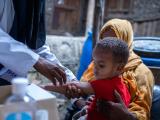Aug 19, 2010 (CIDRAP News) – Federal health officials, in releasing today a blueprint for overhauling the nation's civilian biodefense program, called for increased government partnerships with the private sector and a number of innovative steps to boost the development of medical countermeasures (MCMs) that have little or no commercial market.
Among other things, the report from the Department of Health and Human Services (HHS) calls for establishing special centers to provide surge production capacity for vaccines and advanced development and production of other MCMs. It also recommends setting up an independent "strategic investment firm" to work with small companies and private investors to generate new technologies for countermeasures.
The report, titled "The Public Health Emergency Medical Countermeasures Review: Transforming the Enterprise to Meet Long-Range National Needs," also calls for various steps to improve the Food and Drug Administration (FDA) regulatory process for new countermeasures and advocates increased efforts to help translate new discoveries into usable biodefense products.
The HHS report was released simultaneously with a report from the President's Council of Advisors on Science and Technology (PCAST) on how to speed up influenza vaccine manufacturing to guard against future pandemics. The HHS report offers recommendations on flu vaccine production that match up with those in the PCAST report. They call for faster ways to develop seed viruses for vaccine production and to test the potency and safety of new vaccines, among other things.
At a morning press conference on the two reports, HHS Secretary Kathleen Sebelius said her department is "working toward a nimble, flexible capacity to produce countermeasures rapidly in the face of any attack or threat, known or unknown, including novel naturally occurring infectious diseases."
She also said a general theme of the report is that the MCM program needs to focus more on children's needs, since adult formulations and dosages of biodefense drugs often are not approporiate for them.
As for cost, "About $1.9 billion has been allocated and identified to get these activities off the ground," Nicole Lurie, HHS assistant secretary for preparedness and response, said at the press conference. "The current funding has been identified from current allocations to HHS, in large part by reallocating flu funds." Sebelius explained that much of the money comes from the 2009 supplemental appropriation for the pandemic response.
Lurie said she expects that the funding will break down as follows: about $170 million for regulatory science initiatives at the FDA, $678 million for flexible manufacturing (the centers to provide vaccine production surge capacity), $33 million for efforts by the National Institute of Allergy and Infectious Diseases to translate discoveries into products, $822 million for improving flu vaccine production, and about $200 million for the strategic investment firm.
Sebelius called for a major review of the MCM program last December, after delays in production of the pandemic H1N1 flu vaccine left most of the population without good access to it until after the second wave of cases peaked in October and November. Release of the report originally was expected in March.
Lurie said her office consulted with many people in preparing the report, including PCAST members, biotechnology industry leaders, academicians, venture capitalists, and investment bankers.
"We're really quite excited about having come through H1N1, and having seen reports about the new superbug, we have a tremendous sense of urgency about getting things done," she said, alluding to recent reports of bacteria rendered impervious to many antibiotics because of the NDM-1 resistance factor.
In cataloging the main recommendations, Sebelius led off with the need to "strengthen regulatory science at the FDA," saying that cutting-edge products are often being evaluated using "science that's decades old."
FDA Commissioner Margaret Hamburg said her agency supports enhanced review of new products for highest-priority MCMs and promised to speed programs toward approval by identifying bottlenecks and issues as they emerge.
According to the report, particular goals in the regulatory arena include helping to identify animal models and surrogate measures of product efficacy, expanding the ability to pre-qualify mobile or convertible manufacturing facilities, and improving potency, sterility, and stability assays.
In addition, Hamburg pledged to work with HHS and other government partners "to conduct an examination of the legal framework as well as policy approaches towards MCM development and to assess adequacy and improvements needed."
The second major goal is to develop flexible manufacturing, said Sebelius. "Too many of our facilities are filled with big equipment that's designed to produce just one product over and over. That works for seasonal flu vaccine, but it's not good for something we don't use regularly or haven't invented yet."
The report advocates setting up "Centers for Innovation in Advanced Development and Manufacturing" of MCMs, which will advance "state-of-the-art, disposable, modular manufacturing process technologies."
Besides providing vaccine surge production capacity and development and production of certain other MCMs, the report states, other goals of the centers include:
- Providing additional capacity to make clinical investigation lots of candidate vaccines and manufacturing capacity to respond to emerging disease outbreaks
- Providing additional vaccine production capacity for products such as small-market vaccines used by the Department of Defense
HHS's Biomedical Advanced Research and Development Authority (BARDA) will lead the effort to set up the centers, said BARDA Director Dr. Robin Robinson. "This initiative will primarily support construction and operation of new facilities and renovation of existing facilities in the US to provide core development and manufacturing services to small biotech companies," he said.
Sebelius said the third major recommendation is to nurture relevant discoveries at the earliest stages. "We will use a wide array of NIH [National Institutes of Health] resources for recognizing the potential of new discoveries."
The report cites a number of government programs that already aim to help translate new discoveries into drugs, vaccines, and devices. HHS will now take several new steps to augment these efforts, including the use of "Early Devleopment Teams" that would work closely with government agencies, academic researchers, and industry to provide strategic guidance for researchers.
Dr. Anthony Fauci, director of the National Institute of Allergy and Infectious Diseases, referred to this role as serving as "a guide or sherpa" for researchers, to help them apply for NIH grants and gain access to things like reagents and clinical trials networks.
The fourth goal is to improve and accelerate flu vaccine manufacturing to prevent the kind of delays that occurred during the 2009 pandemic. Sebelius said the recommended steps are the same things discussed in the PCAST report.
Besides envisioning better tests for vaccine potency and sterility, the report says HHS should develop a network of existing facilties that are pre-qualified and under contract to fill and finish vaccine for US government–contracted vaccine manufacturers in a public health emergency.
Further, the report recommends that HHS "support the development of at least three influenza vaccine candidates whose manufacture does not depend on virus grown in eggs or cells in an effort to both increase capacity and ultimately speed delivery" of vaccines.
Commenting on the recommendations, CDC Director Dr. Thomas Frieden said, "We all hope for a game changer—a universal vaccine or a recombinant vaccine that could be made quickly and in large quantities. But we can use existing tools to cut days, weeks, or even a month or two out of the vaccine production process."
The fifth goal highlighted by Sebelius is to establish a strategic investment firm to nurture new MCMs for which there is little commercial incentive, a step that will require congressional action. She likened the approach to "a kind of nonprofit venture capital ability."
"The envisioned MCM Strategic Investor would partner with small 'innovator' companies and private investors to generate novel technologies for the required MCMs," the report states. "Its mission would be the development of novel technologies that have the potential for sustainable commercial applications while demonstrating applicability in the MCM public health space." The firm would operate independently as a 501(c)(3) organization or something similar.
Three top priorities for the organization would be (1) novel antimicrobials for multidrug-resistant pathogens, (2) new mechanisms for disrupting pathogenesis by focusing on host pathways used by different pathogens, and (3) "multiuse platform technologies for diagnostics, vaccines/prophylaxis, and therapeutics."
In response to questions, Fauci said the strategic investment firm will work to enhance the viability of small companies developing new MCMs, in contrast to BARDA, which focuses mainly on getting specific products through the development stage.
The report also includes some recommendations on leadership and administration of the MCM program. It calls on HHS to "identify a dynamic leader whose sole job is to coordinate and integrate the multiple efforts and programs" dealing with MCMs. Other recommendations relate to coordination within HHS, better HHS coordination with other federal agencies, and several other topics.
Dr. Phil Russell, former senior adviser to the HHS Office of the Assistant Secretary for Preparedness and Response, praised several aspects of the report but gave it an overall C+ grade when CIDRAP News asked him to evaluate it today. Russell, who is on the board of the Sabin Vaccine Institute and is former director of the Walter Reed Army Institute of Research, had not had time to read the whole report.
"It's right-on with regard to the FDA piece: enhancement of regulatory science and focus on short-term measures with the flu vaccine. I think that's great," he said. He praised the goal of developing new vaccine potency and sterility assays and improving the making of seed viruses.
He also praised the group's focus on improving the capacity to develop and manufacture vaccines, but he worried that HHS will spread funding across too many organizations rather than focus it on fewer, possibly more meaningful ones. "Execution is going to be the most important problem," he said.
Russell found the section on strategic leadership and administration very vague. He said the problem is not coordination but effective leadership. "If they can find the leadership and execute it [the report recommendations], it will be great. If not, it will fail," he said. "Someone has to make it happen and be accountable."
He had praise for the various efforts to help start-up companies develop promising products, commenting, "Start-ups are weak in intellectual, technical, and financial resources. They need more horsepower. A competent development organization to support them will do great things."
See also:
HHS MCM site with access to full report
http://www.phe.gov/Preparedness/mcm/enterprisereview/Pages/default.aspx



















